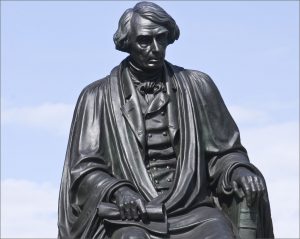Horrible Justice No Longer Has Horrible Statue
We'll remember the Chief Justice's legacy just fine.

Image by Ron Cogswell via Flickr
“The Hon. old Roger B. Taney has earned the gratitude of his country by dying at last. Better late than never.”
Those were the words George Templeton Strong used to memorialize the late Supreme Court Chief Justice Roger Taney when he died in 1864. A few months after his death a bill was considered to create a bust of the late Chief Justice for display in the Supreme Court’s chamber. The Senate rejected the legislation with several senators making clear their distaste for the late Chief:

Is The Future Of Law Distributed? Lessons From The Tech Adoption Curve
Radical Republican Charles Sumner of Massachusetts argued that “an emancipated country” should not honor the author of the infamous Dred Scott decision. A New Hampshire senator similarly pointed out that Taney “sank into his grave without giving a cheering word or a helping hand to the country he had vainly sought to place forever by judicial authority under the iron rule of the slave-masters.”
He eventually got his bust. Like a lot of honorifics for the South, it came after the fact.
As for the Chief Justice’s legacy, well, we know exactly how he should be remembered. Taney penned a vile defense of slavery in Dred Scott — the case that scholars have said “stands first in any list of the worst Supreme Court decisions — Chief Justice C.E. Hughes called it the Court’s greatest self-inflicted wound.” No legal mind — hell, no one with at least a 6th grade education — is going to forget that any time soon. Nor will any forget that Chief Justice Taney used the force of his position as the head of the judicial branch to actively fight President Abraham Lincoln.
Last night, under cover of darkness, workers removed the statue of Chief Justice Taney that sat on the grounds of the Maryland State House. The governor, Larry Hogan (R), previously defended the statute as a remembrance of history, until the violence in Charlottesville. He now says:
Sponsored

The Business Case For AI At Your Law Firm


Is The Future Of Law Distributed? Lessons From The Tech Adoption Curve

Legal AI: 3 Steps Law Firms Should Take Now

Navigating Financial Success by Avoiding Common Pitfalls and Maximizing Firm Performance
[W]hen it reaches the point where some of these symbols, whether they have historical significance or not, when they become a focal point for racism and violence, then it’s time to do something about it.
Also… it was never a great looking statue:
“It’s just a bad statue overall,” said Robb Tufts, 43, of Annapolis. “We deserve to celebrate the heroes of Maryland, not the villains of history.”
As the debate over Confederate monuments rages on, let’s understand what history is being remembered. Dred Scott is still there. Frankly, those awful words are the brutally honest memorial to the Chief Justice that’s needed, not sculpted bronze. We don’t forget that. All we’re forgetting today is that at some point — after the Civil War — Maryland decided to throw taxpayer dollars into honoring a man who was so reviled by the nation when he died that his obituary said his greatest service to the nation was dying.
A statue of Taney isn’t about remembering the past. Removing his ugly statue is about rejecting a propaganda piece erected after the Civil War to rewrite the villains of history as noble servants to a lost cause. In 1872, when the Taney statue went up, it wasn’t about honoring the man. It was a deliberate effort on the part of Maryland officials to deny the history of the Civil War and the Dred Scott decision that preceded it.
Sponsored

Navigating Financial Success by Avoiding Common Pitfalls and Maximizing Firm Performance

Early Adopters Of Legal AI Gaining Competitive Edge In Marketplace
This isn’t about forgetting or sanitizing history. Contrary to the talking point glibly tossed around on Twitter, it is this statue’s existence that denied history. The statue itself served as a monument to forgetting the reality of Taney’s career. Fidelity to history would actually demand scrubbing this lie from existence. It should be gone.
And now it is.
Kathryn Rubino is an editor at Above the Law. AtL tipsters are the best, so please connect with her. Feel free to email her with any tips, questions, or comments and follow her on Twitter (@Kathryn1).
Joe Patrice is an editor at Above the Law and co-host of Thinking Like A Lawyer. Feel free to email any tips, questions, or comments. Follow him on Twitter if you’re interested in law, politics, and a healthy dose of college sports news.







